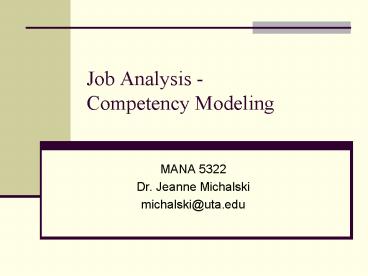Job Analysis - Competency Modeling - PowerPoint PPT Presentation
1 / 20
Title:
Job Analysis - Competency Modeling
Description:
Title: Foundations of Organizational Behavior Author: American Honda Motors Company Last modified by: Jeanne Michelski Created Date: 5/20/2001 7:10:47 PM – PowerPoint PPT presentation
Number of Views:49
Avg rating:3.0/5.0
Title: Job Analysis - Competency Modeling
1
Job Analysis - Competency Modeling
- MANA 5322
- Dr. Jeanne Michalski
- michalski_at_uta.edu
2
Competency Models
- Competency models identify the knowledge, skills,
and abilities necessary to successfully perform
critical work functions across an organization,
industry, or occupation. - A competency model is a model that describes the
requirements and attributes for competent
(successful or exemplary) human performance in
one or more roles or performance settings. As
such, the elements of a competency model
communicate, in clear terms, the circumstances
and conditions of performance.
3
Competency Example
- An example of a competency is "conceptual
thinking", defined as finding effective
solutions by taking a holistic, abstract or
theoretical perspective. A person demonstrating
this competency would probably be able to - Notice similarities between different and
apparently unrelated situations - Quickly identify the central or underlying issues
in a complex situation - Create a graphic diagram showing a systems view
of a situation - Develop analogies or metaphors to explain a
situation - Apply a theoretical framework to understand a
specific situation
4
Competency Models
- Core Competencies for sustainable competitive
advantage. - More general descriptions that cut across many
categories of jobs. - Integrated with selection, training, and
performance management. - Competencies ?Behavioral indicators ?Validation
5
Elements of Competency Model
- Depends on Purpose no agreement, but generally
include - Significance of meeting organizations strategies
(sometimes implied in the development of core
competencies) - Expected outputs or results of performance
- Competencies for fully successful performance
- Competencies that distinguish exemplary
performance (if identified) - Behavioral indicators that describe when
competence is being used appropriately
6
Developing A Competency Model
7
Steps in Developing Competency Models
- Gather Background Information
- Catalog and review existing resources
- Decide for each job family how to gather data
- Comprehensive job analyses
- Expert panel
- Structured interview
- Identify set of generic competencies, if possible
8
Steps in Developing Competency Models
- Collect and Analyze Data
- Identify themes
- Develop draft model
- Competencies
- Clusters
- Indicators or levels
9
Steps in Developing Competency Models
- Review with sponsors/key leaders
- Discuss each competency
- Names and definition
- Specific behaviors used to describe competency
- Elimination of any competency
- Additional competencies
- Revise model
- Communicate Model and Uses
10
Anheuser-Busch Competencies
- Task force (HR staff and facilitator) identified
key business imperatives. - HR Staff and consultants
- Company strategy and business objectives
- Mission and values
- Focus groups of managers reviewed competencies
- Narrowed and prioritized list
- Confirm or edit 4-5 specific employee behaviors
for each competency
11
Anheuser-Busch Competencies
- Questionnaires sent to supervisors who were asked
to rate the frequency that each behavior was
exhibited by - Top performers role models
- Satisfactory or competent employees
- Employees who need improvement
- Completed competencies integrated with selection
and performance management system.
12
I. Achieving Competitiveness
- Customer Focus Aggressively monitors and
anticipates customer requirements and responds to
them in an appropriate manner. - Business Focus Strategically monitors business
performance and environment to enhance
competitive position. - Innovation and Change Actively seeks out new
ideas and displays creativity in adapting to
changing conditions. - Results Orientation Demonstrates the drive and
persistence to meet and exceed job goals for self
or other. - Analysis and Planning Uses critical thinking to
solve problems and develop effective work plans. - Systems Thinking Improves and integrates
business process to meet organizational strategic
goals. - Technical / Functional Expertise Demonstrates,
enhances, and shares job-related knowledge and
skills.
13
II. Succeeding Through People
- Valuing people Demonstrates respect for others
regardless of personal background. - Commitment to Development Develop own and
others capabilities to better meet
organizational needs. - Professionalism Demonstrates candor, composure,
and commitment to obligations in work
relationships. - Empowerment Delegates or accepts responsibility
to expand own capabilities to take appropriate
risks and make decisions. - Influence Uses appropriate methods to motivate
others. - Team orientation Accepts the team approach and
takes necessary action to support its processes
and goals.
14
Performance Levels for Persuasion
- Persuasion - Influencing the behaviors or
actions of others. The changes in behaviors or
actions may not be observed immediately.
15
Uses for Competency Models
- Selection
- Training
- Performance Management
- Developmental Planning
- Career Pathing
- Compensation
16
Common Barriers to Success of Competency Models
- Lack of expertise in building models
- Complexity of some models seems confusing
- Limited support by top management
- Competing priorities
- Lack of resources
- Lack of linkage with organizational strategy
- Lack of ongoing evaluation
- Not integrated with all HR processes
17
(No Transcript)
18
Industry-wide Financial Services
- Business Operations Performs activities
associated with transaction management and
understands the business operations performed by
organizations within the financial services
industry. - Critical Work Functions
- Exercise appropriate techniques to gather client
information. - Examine clients money management patterns to
determine a clients financial situation. - Describe procedures necessary to execute
financial transactions. - Use financial information to manage client
records.
19
Industry-wide Financial Services
- Business Operations (continued)
- Financial Organizations
- Understands the roles and activities provided by
organizations within the financial services
industry, including banks, investment banks,
insurance companies, and stock brokerages. - Transaction Management
- Demonstrates the ability to process financial
transactions without error - Resolves cash discrepancies, and maintains
accurate records of transactions - Understands the principles of confidentiality as
they relate to transaction management.
20
- Advantages of competency models
- Disadvantages of competency models






























